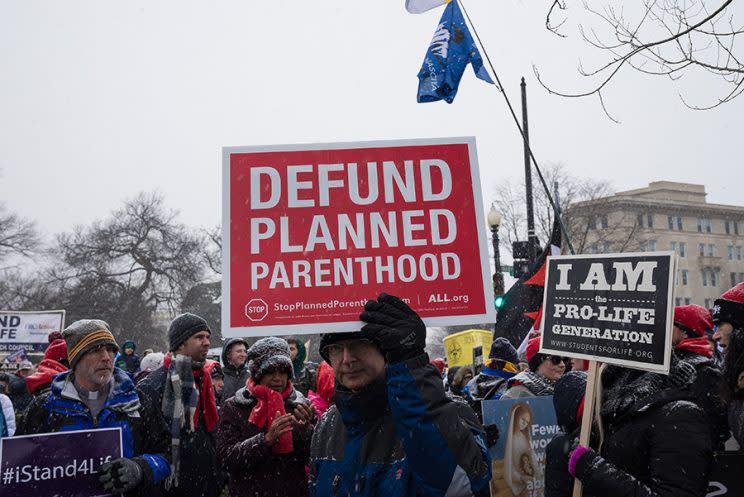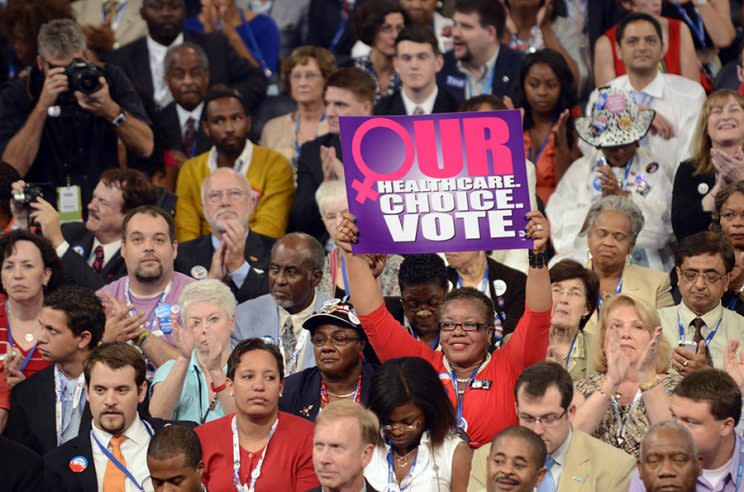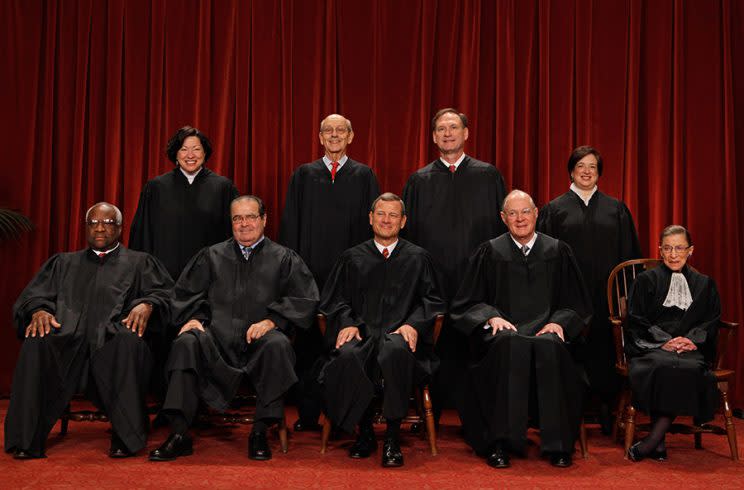How, Exactly, Could Roe v. Wade Be Overturned?

With the inauguration of Donald Trump as the 45th president of the United States on Friday, the Women’s March on Washington on Saturday, and the 44th anniversary of the Supreme Court’s ruling on Roe v. Wade on Sunday, Jan. 22, the state of access to abortion in the United States is in question.
Throughout his presidential campaign, Trump promised to appoint justices to the Supreme Court who would guarantee to overturn Roe v. Wade, eliminating legal abortion nationwide.
Before the election, Trump also sent a letter to the Susan B. Anthony List, an anti-choice activist group, outlining his policy commitments on reproductive rights, which included not only the nomination of justices who would overturn Roe v. Wade, but also the defunding of Planned Parenthood, the implementation of a federal 20-week abortion ban, and making the Hyde Amendment — legislation that bars the use of federal funds to pay for most abortions — into a permanent law.

But the appointment of justices to the bench would not in and of itself be enough to end Roe. Which is why we asked legal experts what a legal challenge to Roe would look like — and what’s really at stake for the future of reproductive rights in the United States.
There’s no reason to think that the current court would change its mind:
“The antiabortion activists have always wanted to overturn Roe v. Wade,” notes Gretchen Borchelt, vice president for reproductive health and rights at the National Women’s Law Center. “Generally, this would work by passing legislation at the state level that presents a square challenge to Roe v. Wade — perhaps by implementing an outright abortion ban — with the hope that the law would be challenged, work its way through the courts, and then ultimately make it to the Supreme Court, where their ruling would effectively overturn Roe. To date, the court has never taken this opportunity. It’s been over 40 years now, and the court has said that women have a constitutional right to have an abortion. So, there’s no reason to think that the court would just change its mind and completely go the other way.”
That said, we have an incoming president who has said his priority in naming a justice to the court would be to appoint one willing to overturn Roe. The question, says Borchelt, is whether he will be able to appoint a sufficient number of justices who want to overturn the legislation.
At present, the Supreme Court has five justices who would vote to uphold Roe — Justices Ruth Bader Ginsberg, Elena Kagan, Sonia Sotomayor, Anthony Kennedy, and Stephen Breyer. The present vacancy on the court created by the death of Justice Antonin Scalia last year does not change the number of votes in support of maintaining the precedent set by Roe, nor would the appointment of just one antiabortion justice to fill that vacancy.
If any of the five current pro-Roe justices leave the bench, Roe could be in trouble:
So, as Borchelt puts it, a real threat to Roe would only occur if any of the five pro-Roe justices were to leave the bench for any reason. If that were to happen, she says, “then Roe would be in jeopardy.”
Should this happen, what is likely to happen next is that a state would pass a law that squarely challenges Roe v. Wade with a total ban on all abortion. If that law were to pass a state legislature and be signed by a governor, it would absolutely be challenged, since under Roe, it would be unconstitutional. Furthermore, such a law would stand to criminalize both providers and patients, meaning they would likely be the plaintiffs in such a case. Depending on the rulings of lower courts, the case would first have to be appealed through district and appellate courts before eventually reaching the Supreme Court for consideration, where the Supreme Court would then have to decide whether to hear the case.
But the current court can chip away at Roe, and has been doing so:
Borchelt notes that even if the Supreme Court maintains the number of votes needed to continue to uphold Roe, it might still concurrently chip away at it.

“Kennedy has spoken about upholding Roe, but has also chipped away at it,” Borchelt says. “In 2007, he voted in favor of a ban on a particular method [for abortion procedures] — meaning some women with serious health conditions couldn’t get the care they needed. Even though there is a solid majority [of justices] in favor of Roe right now, it wouldn’t mean that some of those same justices wouldn’t also allow for an erosion at this right and a chipping away at this right.”
Should there come a point where the Supreme Court did decide that there is no constitutional right to abortion access, Borchelt explains that this would then leave the question of abortion access up to the states; each state could then decide for itself whether to legalize or ban abortion.
“We would return to a situation where a woman’s right to abortion would depend on where she lives. A woman in a state like New York would have access, but a woman in Texas or Mississippi may not be able to get an abortion. We would really go back to the pre-Roe era, where women with means will find a way to access abortion care, while women without will be left without choices,” Borchelt says.
Borchelt also notes that last year’s ruling by the Supreme Court in the case of Whole Woman’s Health v. Hellerstedt “changed the landscape” of the kinds of restrictions states can impose to limit and restrict access to abortion.
That ruling, she says, made clear to antiabortion activists and politicians that avenues other than onerous regulations on abortion providers and clinic facilities will need to be explored to continue to restrict abortion access on the state level.

And indeed, reproductive rights experts say that is exactly why the most attention right now should be paid, and continued to be paid, to the ways in which state legislatures are chipping away at abortion access.
“One of the important things to note is that although there is lots of buzz around whether Roe v. Wade will be overturned — and whether without abortion recognized as a constitutional right under federal law, if the states could then choose to ban abortion on their own — it is still important to recognize that the right to abortion has long been at risk. There has been a steady chipping away at abortion going on for decades,” Brigitte Amiri, senior staff attorney at the American Civil Liberties Union’s Reproductive Freedom Project, tells Yahoo Beauty.
“If we’re only focused on the ultimate question of whether Roe v. Wade will be overturned, then we’re missing what’s been going on under our noses for the past several decades, which is that restrictions upon restrictions have been passed to limit access to abortion care in the states. Some women live in parts of this country where it’s as if Roe v. Wade never happened, because of restrictions that have been piled up,” Amiri says. “I don’t want people to be so focused on the extreme issue of a Roe overturn that they do not see the open bull’s-eye on the other side — sure, abortion can remain a constitutional right, but let’s make it so that no one can get one. That’s been the goal for a long time for antiabortion organizations, and it’s just as important that our attention and outrage be focused there.”
Amiri points to the way that state legislatures have passed abortion bans at as early as 12 and 6 weeks of gestation as a prime example of the way that the right to abortion, even if it is constitutionally guaranteed under Roe, can become no more than hypothetical to women living in some states.
Related: This Beautiful Photo of Ballerinas of Color Is Slaying on Instagram
Let’s keep in touch! Follow Yahoo Beauty on Facebook, Twitter, Instagram, and Pinterest.

